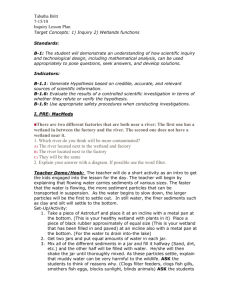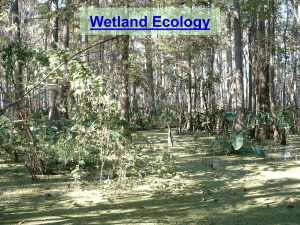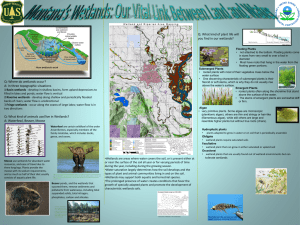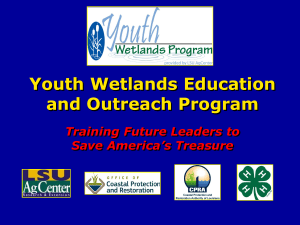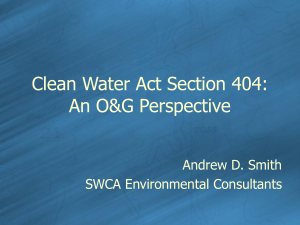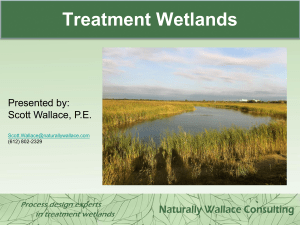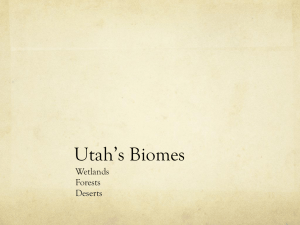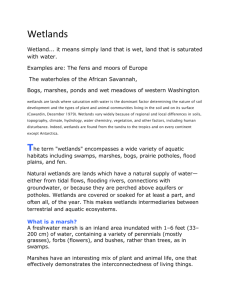wetlands-powerpoint
advertisement
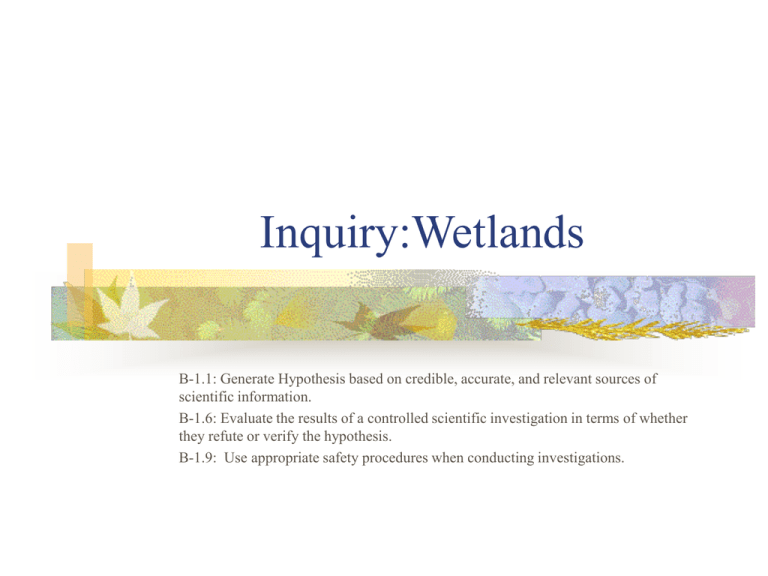
Inquiry:Wetlands B-1.1: Generate Hypothesis based on credible, accurate, and relevant sources of scientific information. B-1.6: Evaluate the results of a controlled scientific investigation in terms of whether they refute or verify the hypothesis. B-1.9: Use appropriate safety procedures when conducting investigations. PRE-MacModS (See Hand-out) There are two different factories that are both near a river: The first one has a wetland in between the factory and the river. The second one does not have a wetland near it. 1. Which river do you think will be more contaminated? A) The river located next to the wetland and factory B) The river located next to the factory C) They will be the same 2. Explain your answer with a diagram. If possible use the word filter. “Runoff Race” As I am shaking the jar, think about this: What are some reasons why muddy water can be harmful to wildlife? Do you think more sediments settle to the bottom if the water is moving fast or slow? “Runoff Race” Flowing water carries sediments of many different sizes. When water is flowing fast, the sediments can be carried in suspension with the water. When the water slows down, larger particles can settle out. Runoff is the movement of land water to the oceans, chiefly in the form of rivers, lakes, and streams. (http://ww2010.atmos.uiuc.edu/(Gh)/guides/mtr/h yd/run.rxml) What does this have to do with wetlands? -Water enters through a stream, goes through the wetland, and then finally into a lake or larger body of water. -Wetlands and their plants can slow the flow of water by just simply being in the way. -The Astroturf is our “healthy wetland” with plants and trees in it and the black surface is a wetland that has been filled in and paved. -Watch what happens…… “Runoff Race” 1. 2. 3. SO…. Which “wetland” produced the fastest water flow? In which wetland would more sediments settle out? Which one would have cleaner water flowing from it? OH..What is a wetland you ask? “Wetlands are areas that are covered by water or have waterlogged soils for long periods during the growing season. Plants growing in wetlands are capable of living in saturated soil conditions for at least part of the growing season. Wetlands such as swamps and marshes are often obvious, but some wetlands are not easily recognized, often because they are dry during part of the year or "they just don't look very wet" from the roadside.” There are 4 major classes of wetlands:Marshes, Swamps,Bogs, and Fens. http://www.sam.usace.army.mil/PA/regulatory/Wetland.htm Marshes… 1. 2. Marshes are periodically saturated, flooded, or ponded with water and characterized by herbaceous (non-woody) vegetation adapted to wet soil conditions. Marshes are further characterized as tidal marshes and non-tidal marshes. Tidal (Coastal) Marshes-Influenced by tides and have salt-tolerant plants. (glasswort and cord grass) Salt marshes are an example. Non-Tidal (Inland) Marshes-Occur in poorly drained depressions, floodplains, and shallow areas along lakes and rivers. The Florida Everglades are an example. http://www.epa.gov/wetlands/pdf/types_pr.pdf Marshes… Florida Everglades inland marsh Salt Marsh Swamps… SWAMPS are fed primarily by surface water inputs and are dominated by trees and shrubs. Swamps occur in either freshwater or saltwater floodplains. They are characterized by very wet soils during the growing season and standing water during certain times of the year 1. Forested swamps-Receive floodwater from nearby rivers and streams. Trees include bald cypress, water tupelo, white oak, and red maple. 2. Shrub swamps-Similar to forested accept buttonbush and swamp rose dominate. 3. Mangrove swamps-Coastal wetlands characterized by salt-tolerant trees and plants. http://www.epa.gov/wetlands/pdf/types_pr.pdf Swamps… Forested Swamp Mangrove Swamp Bogs… BOGS are freshwater wetlands characterized by spongy peat deposits, a growth of evergreen trees and shrubs, and a floor covered by a thick carpet of sphagnum moss. These systems, whose only water source is rainwater, are usually found in glaciated areas of the northern United States. One type of bog, called a pocosin, is found only in the Southeastern Coastal Plain. Bogs… Pocosin Fens… FENS are ground water-fed peat forming Wetlands covered by grasses,sedges, reeds, and wildflowers. Willow and birch are also common. Fens, like bogs, tend to occur in glaciated areas of the northern United States. Fens… Did you know that… There are approximately 4.5 million acres of wetlands in South Carolina. Wetlands cover about 23% of South Carolina’s total land surface. South Carolina wetlands constitute about 12% of the total amount of wetlands in the United States. South Carolina has lost abut 27% of it’s wetlands since the middle 1700’s. (SCDHEC, 2009) Investigative Question: What function of a wetland contributes to the productivity of this ecosystem ? Hypothesis: If wetlands are one of the most productive ecosystems on earth, then ________________________________________________________________________________ ________________________________________________________________________________ ________________________________________________________________________________ ___________________________________________________________________________.. Materials: Please check that you have the following materials and raise your hand if you are missing something: 1. Clear plastic bottle ½ cup dirt 2 cups of sand 2 cups of large gravel 1 cup of small gravel 1 cup of water Spoon Plastic cup 2. 3. 4. 5. 6. 7. 8. Modeling a wetland Lab Procedures: Leave the cap on the bottle. Turn the bottle upside down so that the closed cap is facing down and add 2 cups of gravel in it. Now, add 1 cup of smaller gravel on top of the larger gravel. Pour the sand in. ( Notice it will fill the gaps in the gravel) Take your cup of water and mix in ½ cup of dirt. In your science journal make a prediction about what you think the water will look like after it seeps through and explain why. Slowly pour your dirt/water mixture in. Place the bottle over your plastic cup and slowly remove the cap from the bottle. Watch as the water seeps in through the sand and gravel. In your science journals, generate a hypothesis about what part of a wetland the filter is representing and draw a model that demonstrates this. Compare what the water looked like before it passed through the filter and what it looked like after it passed through the filter. Let’s Talk… What are your ideas about this filter? How is this filter representative of a wetland? What component is the filter representing? What function? How Do Wetlands Help? “Harmful substances are often introduced into water bodies like streams, rivers, ponds, and lakes. Factories may dump toxic chemicals, or rainwater may carry harmful pesticides or animal waste from farms. Such harmful substances can have negative impacts on the wildlife that live in these water bodies. These substances may also enter the groundwater, which is where people get their water to drink!” “Wetlands reduce the amount of these harmful substances that enter a stream, river, pond, or lake by acting like a strainer that filters out the bad stuff. When these substances enter a wetland, before reaching the water body, wetland plants will take many of the harmful substances into their roots and change the harmful substances into less harmful ones before they are released to the water body. Harmful substances may also be buried in wetland soil, where bacteria and other microorganisms break the substances down so they are no longer harmful.” http://techalive.mtu.edu/meec/module12/Chemicalfunctionsofwetlan ds.htm How Does a wetland work In your science journals: I refute/Verify(pick one) my hypothesis that __________________________ because _________________________________. “Our Wonderful Wetlands” Streamline Video POST-MacModS( See Hand-Out) 1. 2. There are 3 acres of land located in North Myrtle Beach, SC. On that land, there is a large wetland that directly borders the ocean. A developer came along and offered the land owner 1.5 million dollars for the land- SOLD! The developer decided to build a strip mall there. What do you think will be the effect on the water quality in the ocean near the new strip mall? Draw a diagram that depicts your explanation. References http://beachwoodhistoricalalliance.files.wordpress.com/2009/03/wetlands-diagram.jpg http://techalive.mtu.edu/meec/module12/Chemicalfunctionsofwetlands.htm http://www.sam.usace.army.mil/PA/regulatory/Wetland.htm http://www.epa.gov/wetlands/pdf/types_pr.pdf http://www.nature.org/wherewework/northamerica/states/alabama/images/salt_marsh.j pg http://image.absoluteastronomy.com/images/encyclopediaimages/e/ev/everglades_saw grass_prairie_moni3.jpg http://www.fws.gov/r5mnwr/lotw/tupcypress2.jpg http://www.shunya.net/Pictures/Mexico/mangrove-swamp.jpg http://www.learnnc.org/lp/media/collections/cede/cedefire12.jpg http://www.fws.gov/midwest/endangered/img_coll/insects/misa_fen2005MIDNRChris Hoving.jpg http://www2.scholastic.com/content/images/articles/m/msb_wetlandspg.gif
